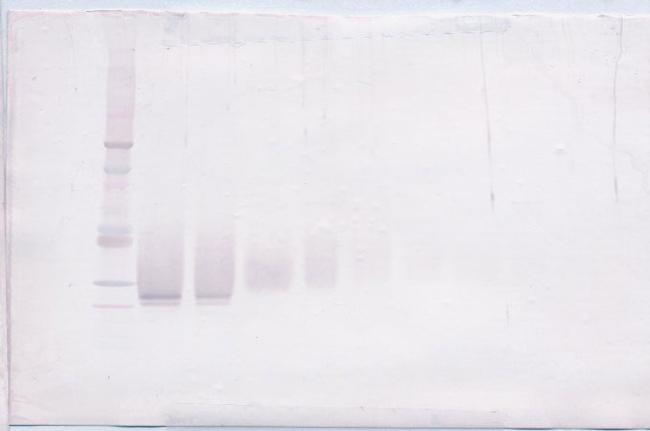Search Thermo Fisher Scientific
图: 1 / 3
FGF17 Antibody (500-P152BT-25UG) in WB



产品信息
500-P152BT-25UG
种属反应
宿主/亚型
分类
类型
抗原
偶联物
形式
浓度
纯化类型
保存液
内含物
保存条件
运输条件
RRID
产品详细信息
AA Sequence of recombinant protein: MTQGENHPSP NFNQYVRDQG AMTDQLSRRQ IREYQLYSRT SGKHVQVTGR RISATAEDGN KFAKLIVETD TFGSRVRIKG AESEKYICMN KRGKLIGKPS GKSKDCVFTE IVLENNYTAF QNARHEGWFM AFTRQGRPRQ ASRSRQNQRE AHFIKRLYQG QLPFPNHAEK QKQFEFVGSA PTRRTKRTRR PQPLT.
Preparation: Produced from sera of rabbits immunized with highly pure Recombinant Human FGF-17. Anti-Human FGF-17-specific antibody was purified by affinity chromatography and then biotinylated.
Direct ELISA: To detect Human FGF-17 by direct ELISA (using 100 µL/well) a concentration of approximately 1.0 µg/mL of this antibody is required. This biotinylated polyclonal antibody allows the detection of at least 2000-4000 pg/mL of Recombinant Human FGF-17.
Western Blot: To detect hFGF-17 by Western Blot analysis this antibody can be used at a concentration of 0.1-0.2 µg/mL. Used in conjunction with compatible secondary reagents the detection limit for Recombinant hFGF-17 is 1.5-3.0 ng/lane, under either reducing or non-reducing conditions.
500-P152BT-1 mg will be provided as 2 x 500 µg
靶标信息
The protein encoded by this gene is a member of the fibroblast growth factor (FGF) family. FGF family members possess broad mitogenic and cell survival activities, and are involved in a variety of biological processes including embryonic development cell growth, morphogenesis, tissue repair, tumor growth and invasion. This gene was shown to be prominently expressed in the cerebellum and cortex. The mouse homolog of this gene was localized to specific sites in the midline structures of the forebrain, the midbrain-hindbrain junction, developing skeleton and developing arteries, which suggests a role in central nervous system, bone and vascular development. This gene was referred to as FGF-13 in reference 2, however, its amino acid sequence and chromosomal localization are identical to FGF17.
仅用于科研。不用于诊断过程。未经明确授权不得转售。
篇参考文献 (0)
生物信息学
蛋白别名: FGF; FGF-17; Fibroblast growth factor; Fibroblast growth factor 17
基因别名: FGF-13; FGF-17; FGF17; HH20; UNQ161/PRO187
UniProt ID: (Human) O60258
Entrez Gene ID: (Human) 8822



